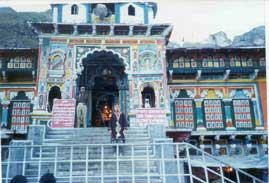|
||||||||||||||||
|
||
BADRINATH |
|
PILGRIM'S COUNTRY |
 An
old Indian proverb goes, "There are many sacred spots of pilgrimage
in the heavens, earth and the nether world, but there has been none
equal to Badri, nor shall there be." Indians, known for their
religious fervor, lay special importance to this holy town. The
etymological root for the name of the town goes to the Badri Van,
where the lush green Badri trees grow. According to a local myth,
the word badri is derived from the wild berry that Lord Vishnu (God
of the Hindu trinity, entrusted with preserving the Universe) survived
on during his reparation at Badri Van.
An
old Indian proverb goes, "There are many sacred spots of pilgrimage
in the heavens, earth and the nether world, but there has been none
equal to Badri, nor shall there be." Indians, known for their
religious fervor, lay special importance to this holy town. The
etymological root for the name of the town goes to the Badri Van,
where the lush green Badri trees grow. According to a local myth,
the word badri is derived from the wild berry that Lord Vishnu (God
of the Hindu trinity, entrusted with preserving the Universe) survived
on during his reparation at Badri Van.
LOCATION
Situated on the right banks of the river Alakananda in the northern
province of Uttar Pradesh, Badrinath is couched within the two mountain
ranges of Nar and Narayan, with the Neelkanth peak on the background.
This breathtaking sight is itself an enchantment for tourists and
is called the "Garhwal Queen." It is located in the northern
district of Chamoli and the nearest cities are Rishikesh (300 km),
Mussourie and Dehradun.
CLIMATE
It is never too hot even in the summers, with night temperatures falling to as low as 10°C. This makes it a pleasant retreat from the other tropical places in the country.
SITES TO VISIT
Tourists, both foreign and local, flock to the temple of Badrinath, which was built by Adiguru Shankaracharya in the early ninth century AD. This acclaimed abode of Lord Vishnu is one of North India's "Four Holy Temple Cities" or dhams along with Puri, Rameswaram and Dwaraka. Badrinath is also known as Tapobhumi (land of meditation and penance) and Bhubaikunth (heaven on earth). It is situated at an altitude of 3133 meters above sea level. Besides the main temple itself, the entrance to the shrine is of special significance. The temple of Badrinathji remains closed from October to April due to the winter snow, when temperatures fall to sub-zero degrees.
Before entering the temple itself, the pilgrims take a holy dip in the Tapt Kund, where there are thermal springs with natural curative properties. It is supposed to be the abode of Agni, the Hindu God of fire. Other famous natural spring sites are Narad Kund and Surya Kund.
The pilgrims generally perform the rites of remembrance and reverence for the departed souls of their near ones in the Brahma Kapal, a flat platform on the banks of the river Alakananda. A rock boulder with the impression of Sheshnag, a mythological serpent, called Sheshnetra, is also a place to visit. The footprints of Lord Vishnu are present on a boulder called Charanpaduka, and are of religious significance. Another important temple is the Mata Murti temple, dedicated to the mother of Badrinathji.
The origin of Alakananda River, Alka Puri, is of special interest to the daring tourists. Satopanth, a triangular lake, is located at a height of 4402 meters above the sea level and is one of the sources of the Alakananda River. It is named after the Hindu trinity-Lord Brahma, Lord Vishnu and Lord Shiva.
At the convergence of the rivers, there are pilgrim sites that are collectively called the Panch Prayag. Devprayag, at the confluence of Bhagirathi and Alakananda, is famous for its rock inscriptions and the temples dedicated to Lord Shiva and Raghunath. Rudraprayag, at the meeting point of Alakananda and Mandakani, is known for the Rudranath and Chamunda Devi temples. Nandaprayag is known for the Gopalji temple. Karnaprayag is the confluence of Alakananda and Pindar rivers and is famous for its temples dedicated to Uma and Karna. The fifth pilgrimage spot is Vishnuprayag, at the confluence of Alakananda and Dhauliganga, where there is a very ancient temple dedicated to Lord Vishnu, besides the pool of Vishnu Kund.
Another pilgrim site is the Panch Badri. Yogadhyan Badri, where there is a meditative idol of Lord Vishnu, Bhavishya Badri, where there are forests nearby, Adi Badri, where there are 16 temples and one big temple of Lord Vishnu, are three of the most famous.
SITES NEARBY
Joshimath is another religious place. It was established by Adiguru Shankaracharya and named it Jyotirmath, which later came to be known as Joshimath. There are other temples dedicated to Goddess Durga and Lord Narsingha. Gobindghat, situated between Joshimath and Badrinath, is an important place for the trekkers. Another very famous tourist attraction is the Valley of Flowers, with the Pushpavati River and Rataban peak nearby. Lok Pal Hemkund is a beautiful lake in the vicinity of the country's highest Gurdwara, Hemkund Sahib.
Mana Village, about 4 km away, is the last village in the Indo-Tibetan border. Other places of interest include Vyas Gufa, dedicated to Sage Ved Vyas; Bhim Pul, the natural bridge over the legendary Saraswati River; the 122-meter-high Vasundhara Falls; Pipalkoti, a place of natural beauty; and Chamoli, a retreat of serene verdure.
HOW TO REACH
The nearest airport is that of Jolly Grant, which is about 317 km from Badrinath. Helicopters and small private airlines are allowed to land there. The nearest railheads are Rishikesh (297 km) and Kotdwar (327 km). Badrinath is well connected to all the major tourist spots nearby, namely, Rishikesh, Hardwar, Kotdwar, Dehradun, and other hill retreats of the Garhwal and Kumaon region. Delhi is 238 km from Rishikesh.
|
||||||||
| Exciting
Tour Packages |
||||||||


